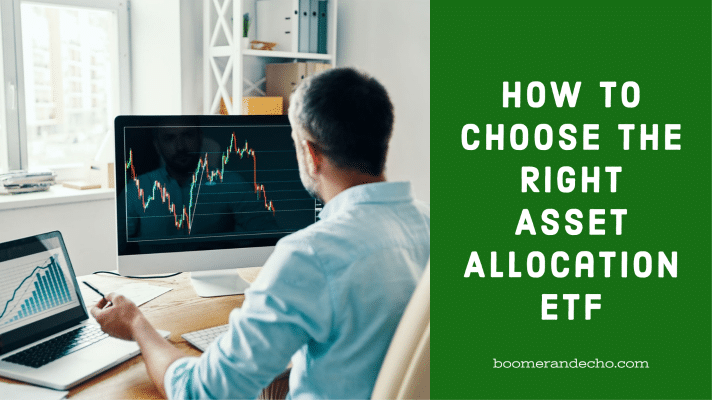How To Choose The Right Asset Allocation ETF


Nobel laureate Harry Markowitz famously said that diversification is the only free lunch in investing. A portfolio concentrated in just a handful of stocks, or one that holds only Canadian or US stocks, may have a much wider range of outcomes than a more broadly diversified portfolio that includes stocks from every country. Most investors should also have some bond exposure to help reduce volatility. Bonds tend to hold their value when stocks fall (yes, 2022 was a notable exception), so when that happens a diversified investor can sell bonds to buy more stocks at a discount.
This concept of diversification and using an appropriate asset mix makes good sense, but it might also make things complicated for the average investor to build a properly diversified portfolio.
However, if investing has been solved with low cost index funds, then investing complexity has been solved with asset allocation ETFs, or all-in-one ETFs.
What are Asset Allocation ETFs?
An asset allocation ETF holds a pre-determined mix of Canadian, US, international and emerging market stocks, plus Canadian, US, and international bonds. It automatically rebalances this mix when markets move up and down, so you don’t have to worry about tinkering with your portfolio.
Let’s say you invest in Vanguard’s Balanced ETF (VBAL). This asset allocation ETF is made up of seven underlying ETFs representing stocks and bonds from around the world. Altogether it holds more than 13,000 global stocks and 18,000 global bonds.
Most major ETF providers offer their own suite of asset allocation ETFs. You’ll typically find the classic 60/40 balanced ETF, an 80/20 growth-oriented ETF, a 40/60 conservative ETF, and even an aggressive 100% equity ETF.
Related: How I Invest My Own Money
For this article, we’re going to stick with the two biggest names in the asset allocation space: Vanguard and iShares.
Vanguard’s asset allocation ETFs include:
- Vanguard’s Conservative Income ETF (VCIP) – 20% stocks and 80% bonds
- Vanguard’s Conservative ETF (VCNS) – 40% stocks and 60% bonds
- Vanguard’s Balanced ETF (VBAL) – 60% stocks and 40% bonds
- Vanguard’s Growth ETF (VGRO) – 80% stocks and 20% bonds
- Vanguard’s All Equity ETF (VEQT) – 100% stocks
iShares’ asset allocation ETFs include:
- iShares Core Income Balanced ETF (XINC) – 20% stocks and 80% bonds
- iShares Core Conservative Balanced ETF (XCNS) – 40% stocks and 60% bonds
- iShares Core Balanced ETF (XBAL) – 60% stocks and 40% bonds
- iShares Core Growth ETF (XGRO) – 80% stocks and 20% bonds
- iShares Core Equity ETF (XEQT) – 100% stocks
This isn’t like the old days when you would try to pick winning mutual funds by looking up their past returns. By nature, over the long term, an all-equity portfolio is going to outperform an 80/20 portfolio, which will outperform a 60/40 portfolio, and so on.
Choosing the right asset allocation ETF starts with determining the most risk appropriate portfolio for your age, time horizon, goals, and your capacity to endure the ups and downs of the market. Too often investors chase past winners and then abandon ship when those winners come crashing down to earth. Conversely, many investors flee to conservative investments after a downturn, only to miss out on the eventual recovery when stocks rise again.
What we want to do is select an asset mix that we can stick to for the long term, regardless of the current market conditions. For many people, that’s the tried-and-true 60/40 balanced portfolio. For others, who maybe have a longer time horizon or a larger appetite for risk, an 80/20 or even a 100% stock portfolio may be perfectly sensible.
You can get a decent sense of your risk tolerance by taking this investor questionnaire on the Vanguard website.
Follow that up by watching this excellent video by Shannon Bender on how to choose the right asset allocation ETF:
I like this video because it gives you an idea of the range of outcomes you can expect from the various asset mixes over time. Hint, you should probably be more conservative than you think over timeframes of less than 10 years.
I use the following assumptions for expected future annual investment returns in my financial planning projections:
Average return assumptions
- Low risk 20/80 portfolio = 3.30%
- Conservative 40/60 portfolio = 4.00%
- Balanced 60/40 portfolio = 4.70%
- Growth 80/20 portfolio = 5.40%
- Aggressive 100% portfolio = 6.10%
Keep in mind these are long-term projections. Investment returns can vary widely in a single year. PWL Capital’s Justin Bender back-tested returns for each of the Vanguard and iShares‘ asset allocation portfolios and found the worst 1-year return for each of them:
Worst 1-year return
- Low risk 20/80 portfolio = -12.18%
- Conservative 40/60 portfolio = -18.85%
- Balanced 60/40 portfolio = -25.49%
- Growth 80/20 portfolio = -31.79%
- Aggressive 100% portfolio = -37.74%
However, the annualized 20-year returns were a lot closer to my financial planning assumptions:
Annualized 20-year returns
- Low risk 20/80 portfolio = 4.24%
- Conservative 40/60 portfolio = 5.14%
- Balanced 60/40 portfolio = 6.01%
- Growth 80/20 portfolio = 6.82%
- Aggressive 100% portfolio = 7.58%
You can see that there isn’t a huge difference in long-term returns between these portfolios. The goal is to be in an asset mix you can stick with for the long term, so if chasing the highest return with 100% stocks is going to cause you stomach-churning anxiety throughout your investing life, then take comfort knowing you’re not giving up much by choosing a balanced or growth portfolio.
Remember, nobody failed to meet their retirement goals because they invested in a sensible low-cost balanced portfolio instead of a more aggressive portfolio.
Strike a compromise between FOMO and fear. What I mean is that you want an asset mix that makes you feel just a little bit of FOMO when stocks are soaring, and feel a little bit less afraid when stocks are falling.
Vanguard, iShares, others?
Okay, so once you’ve selected an appropriate asset mix, you’ll still need to decide which ETF provider to choose (Vanguard, iShares, BMO, TD, Horizons, Mackenzie, and Fidelity all offer a suite of asset allocation ETFs).
I’ll keep this part brief because there’s no need to overthink it.
For simplicity, if you want to narrow down your decision, the asset allocation ETFs offered by Vanguard and iShares are perfectly sensible options for your portfolio. There aren’t enough differences to lose sleep over the decision.
iShares’ asset allocation ETFs are slightly cheaper – they cost 0.20% MER compared to Vanguard’s 0.24% MER at the time of this writing.
In terms of geographical weighting, iShares holds slightly more US equity and international equity, while Vanguard holds slightly more Canadian equity and emerging market equity.
The iShares’ portfolios have also slightly outperformed Vanguard’s pretty much across the board over all time periods, likely owing to US and international equity outperforming Canadian and emerging market equity.
The differences are negligible, though, so pick one provider and stick with it – or hedge your bets by holding a Vanguard product in one account and iShares in another. Just don’t switch between them every year chasing past performance.
Final Thoughts
It has never been easier to be a successful DIY investor than it is today. That’s because new one-stop investing solutions like asset allocation ETFs have taken the complexity out of building and maintaining a portfolio.
They’ll also save you a bundle on fees. Where most mutual fund portfolios charge an average MER of 2%, you’ll pay 1/10th of that with an asset allocation ETF.
If you want to reduce the investment fees that you pay, diversify your portfolio into an appropriate mix of global stocks and bonds, and simplify your investments with an all-in-one automatically rebalancing ETF, then consider switching to a risk appropriate asset allocation ETF.
That’s exactly what my DIY Investing Made Easy video series is designed to do – show you exactly how to make the transition from an expensive and underperforming mutual fund portfolio and into a simple, low cost asset allocation ETF so you can cut your fees to the bone and move on with your life.





